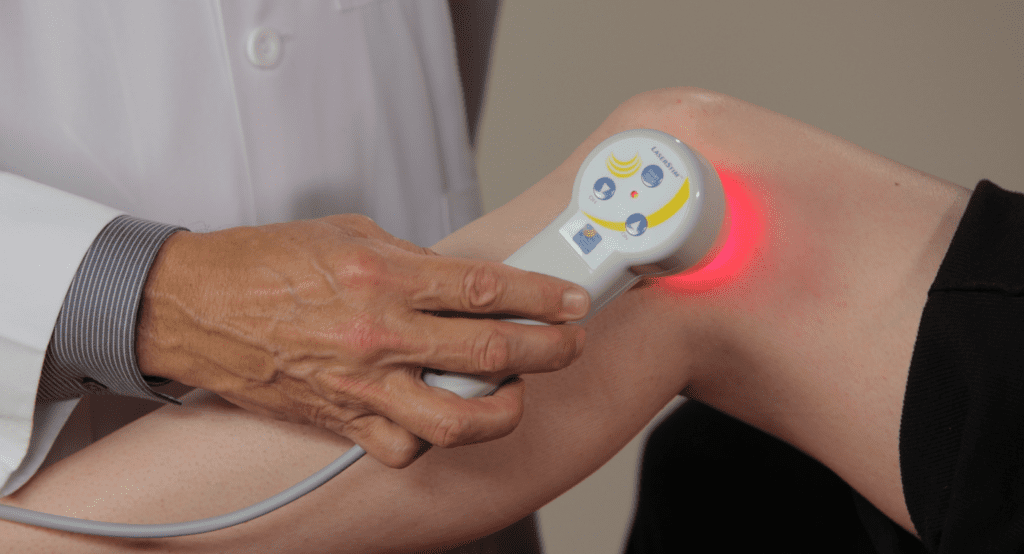
Article Authors: Gordon Slater| Tandose Sambo
Laser therapy is a non-invasive treatment option for osteoarthritic pain. The therapy is also known as low-level laser therapy (LLLT), and utilises concentrated light that is directed at specific sites on the body that need healing. The laser does not apply any heat therapy to the patient, it activates photochemical reactions in the cells that enable the restoration of critical function. Medical science is still proving the full effectiveness of the therapy, and it has had great positive benefits thus far. Laser therapy has proven effective in the treatment of osteoarthritis and rheumatoid arthritis.
Medical studies conducted on patients with rheumatoid arthritis, who were treated with laser therapy showed marked improvement in their condition. Their pain levels and hand flexibility improved, and their morning stiffness reduced. They maintained similar joint function, range of motion and swelling to a standard placebo patient pool. There is room for improvement in the treatment of osteoarthritis patients, and the medical community is to continue to understand the matter further. [1]
Arthritis affects millions of patients globally and presents itself in a multitude of forms. In some instances such as rheumatoid arthritis, multiple organs in the body can be affected at once. Adults over 65 are the predominant patient pool for the varous forms of arthritis, although anyone can be affected. Laser therapy has proven effective in combating the effects of laser therapy. Some benefits are highlighted below[2]:
1)Red light laser blocks the increment of prosta-glandine-1 and bradykinine in the plasma fibrinogen level.
2) Medical observations on animal studies found that after injection of calcium pyrophosphate into rats in order to induce arthritis-like symptoms, that the untreated group exhibited a strong diffuse inflammatory reaction. No inflammation was observed in the laser group.
3) The stimulation of human embryonic fibroblast cells with a GaAs laser was conducted. Maximum increase of collagen production and cell biostimulation occurred after four episodes of laser therapy at 24 hour intervals.
The previous observations were translated into human studies, and various positive clinical effects were identified. These included[2]:
- Stabilization of the cell membrane
- Enhancement of ATP synthesis
- Stimulated vasodilation along with increased histamine, NO and serotonin
- Acceleration of leukocyte activity
- Increased Prostaglandin synthesis
- Reduction in Interleukin-1 levels
- Increased angiogenesis
- Enhanced superoxide dismutase
- Decreased C-reactive protein and neopterin levels
As the chemical interactions in the healing mechanisms induced by laser therapy are known, it is expected that more effective treatments will be available to patients in the near future. There are a variety of different treatment techniques that are commonly used in the application of laser therapy. These include:
Tissue Saturation: A stationary contact with the laser directly pointed on the tissue to be treated.
Lymphatic Tissue Saturation: Utilising the laser emitter in small circular motions over various points on the lymphatic and vascular system.
Acupoint stimulation: This involves stimulating various points on the body, ear or hands.
Conclusion
Application of laser therapy to various forms of arthritis either via one method, or a variety of methods can provide considerable pain relief to patients with either rheumatoid arthritis or osteoarthritis. Your orthopaedic specialist will be able to identify the best treatment combination that will work for you. It is generally recommended that initial treatments are brief, and then the intensity of the treatment be applied until the full dose is administered. This incremental increase will allow the immune system to adapt to the change.
Article References:
- Laser Treatment for Osteoarthritis: https://www.verywellhealth.com/laser-therapy-for-osteoarthritis-does-it-work-2552298
- Therapeutic Laser in the Management of Arthritis:https://www.practicalpainmanagement.com/pain/myofascial/therapeutic-laser-management-arthritis


